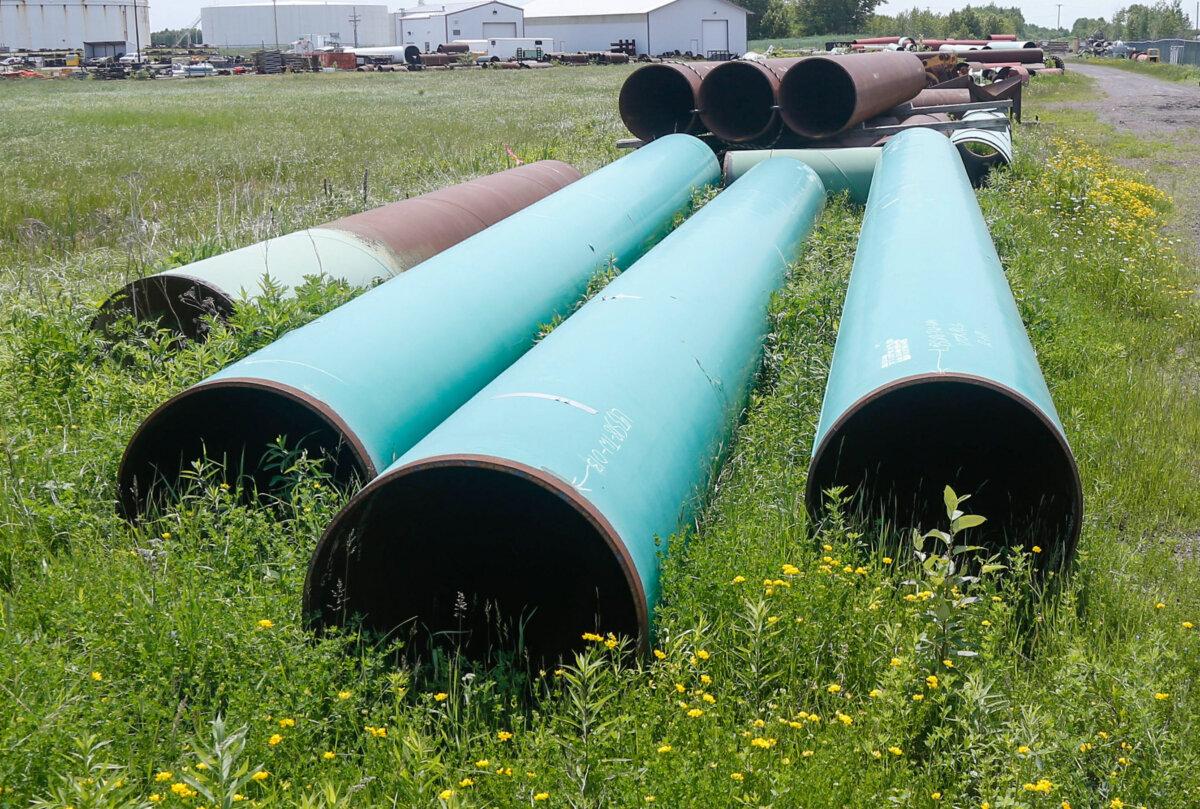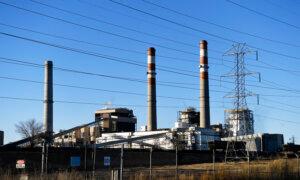More than 220 are eligible for quick approval. While Appalachia and Texas producers push for more interstate access, the Northeast is knotted in bottlenecks.
Many are in oil- and gas-rich regions, such as Appalachia—Pennsylvania, West Virginia, Ohio, Kentucky, North Carolina, and Texas. Producers in Appalachia and Texas are pushing for more access to interstate pipelines to fuel growing demand for natural gas as the nation’s top electricity generator and as liquid natural gas for export.
Not included in the list of 220 proposals are “zombie pipelines” frozen or withdrawn in regulatory limbo from its approval queue.
Some—most notably, the president himself—are calling for exhuming several notable “zombies,” such as the Constitution pipeline in New York and TCEnergy’s Keystone XL.
“Come back to America, and get it built,” Trump beseeched TCEnergy in a February Truth Social post, calling on the Canada-based company to kickstart the proposed 1,200-mile cross-border pipeline it spent millions over nearly 15 years failing to get approved, promising, “Easy approvals, almost immediate start!”
After repeatedly expressing no interest in reviving the project since ending it in 2021, TCEnergy “spun off” its pipeline business to a subsidiary, South Bow. In February, both announced joint plans to expand their Big Sky Pipeline System that could incorporate some aspects of 2008’s XL proposal.
The U.S. Army Corps of Engineers, complying with Trump’s Jan. 20 order to “expedite the completion of all authorized and appropriated infrastructure,” in late February identified 688 projects eligible for rocket-docket regulatory reviews.
In addition to pipelines, other proposed “infrastructure” improvements cited by the Army Corps include liquid natural gas export terminals, at least four coal mines, and dozens of solar energy developments.
The 220 natural gas pipeline-related projects the Army Corps could waive through Clean Water Act hearings include renovations, repairs, expansions, and new digs; some have been in permit review for years.
Demand for natural gas to generate electricity is projected to significantly increase in coming years in response to a dramatic surge in electrification unfolding three-to-four times faster than grid operators and utilities planned as recently as two years ago.
Trump’s “drill baby drill” policy seeks to expand fossil fuel development, especially natural gas—the United States is the world’s largest producer and exporter—to lower domestic electricity costs and pay down the nation’s near-$37 trillion debt.
“We’re adding one customer every second of every day,” American Gas Association CEO Karen Harbert told utility commissioners during a February conference in Washington. “On the business side of things, we have 5.7 million businesses and we’re adding one every minute of every day.”
But as Energy Secretary Chris Wright said on March 10 at CERAWeek by S&P Global in Houston, before industry can drill more natural gas to meet this demand, “We’re going to have to build, baby, build more pipelines.”
“We know that this country has almost 100 years supply of available natural gas,” Interstate Natural Gas Association of America CEO Amy Andryszak told The Epoch Times, “but if you don’t have the capacity in the infrastructure—the pipeline infrastructure—to move it around the country, you’re going to run into real problems.”

During a protest against the construction of the Keystone XL pipeline, American actress Daryl Hannah (C) sits in front of the White House in Washington, on Aug. 30, 2016. Saul Loeb/AFP/Getty Images
Must Expand by 30 Percent
There are about 3 million miles of pipelines that deliver natural gas from field to furnace in the United States, a network the U.S. Energy Information Administration says includes 210 mainline interstate systems stretching more than 305,000 miles nationwide.
The Interstate Natural Gas Association of America estimates more than 2,400 miles of natural gas pipelines must be added each year, and 1,400 compressor stations built, by 2035 to satisfy natural gas demand.
Andryszak said her association’s 27 members own and operate 200,000 miles of interstate pipelines, two-thirds of the nationwide network, and are “very focused” on the need to quickly build capacity to move more gas.
“We’re seeing lots of reports from all different sources about the increase in overall demand for energy and demand for electricity,” she said. “I do believe as a country, we should be concerned about having the necessary energy infrastructure to meet that demand—and pipelines are a key part of that.”
Among the pipeline projects completed last year was the Mountain Valley Pipeline’s extension into Virginia. Its proposed expansion into North Carolina is among projects identified for accelerated “emergency” review by the Corps.
Other pipeline projects completed last year are Transco’s Regional Energy Access from Pennsylvania into New Jersey, Louisiana Energy Access Project Phase 3 expanding access to Gulf ports, and Texas’s Matterhorn Express Pipeline to move more Permian Basin gas.
There are 107 proposed pipeline projects on the pipeline projects tracker in various stages of permitting. A few have been on the books since 2019, some are reiterations of multi-submitted proposals, but the tracker charts at least $15 billion in pipeline improvement and expansion projects.
They include the 300-mile Bison Xpress Project in Wyoming, the 300-mile Alabama-Georgia Connector Project, and the Bakken xPress Project in North Dakota.
It’s a good start, but unless the pace quickens, the gap between projected demand and planned pipelines will continue to grow, American Council for Capital Formation Senior Vice President Kyle Isakower said.
That prognosis remains as “absolutely” true today as it was two years ago, Isakower told The Epoch Times.
“Without additional pipeline capacity, it really doesn’t matter how many more wells you drill, there’s only so much that you can move through the system,” he said. “There’s a need for greater pipeline capacity to bring natural gas from areas of production to the nationwide pipeline system.”

Pipes awaiting use in forming a pipeline. Jim Mone/AP Photo/File
Building Pipelines
Among notable pipeline projects that could see rocket-docket permitting by the Corps under the president’s executive orders and “National Energy Emergency” is Alaska Gasline Development Corporation’s 807-mile pipeline, liquefaction plant, and port project that would build the West Coast’s first liquid natural gas export terminal.
The Army Corps of Engineers also could speed up regulatory reviews for Canadian pipeline operator Enbridge Energy’s controversial plan to replace its 4.5-mile Line 5 pipeline under the Straits of Mackinac linking Lake Superior with Lake Huron.
While eligible for expedited federal review, Line 5 faces significant local opposition and unresolved litigation with Michigan over federal preemption of state regulatory primacy in pipeline siting.
Under Trump’s orders, the Army Corps could accelerate approvals for eight Texas pipeline projects, most seeking to move Permian Basin gas to liquefaction plants and export terminals on the coast, including segments of the 365-mile Blackcomb, 563-mile Apex, and 550-mile-long Bahia pipelines.
More than 100 permits related to Mountain Valley Pipeline’s Southgate extension into North Carolina, as part of the Southeast Supply Enhancement to funnel natural gas from West Virginia and Pennsylvania as far south as Alabama, could be expedited.
Other than Algonquin Gas Transmission’s 6-mile pipeline for its long-proposed Atlantic Bridge Project in Massachusetts, however, there are no pending pipeline “digs” in New England and New York.
“There’s certainly a lack of infrastructure in terms of getting natural gas to consumers up in the Northeast,” Isakower said. “You’ve got New England that’s still using heating oil primarily for home heating, instead of natural gas, which would burn cleaner and be cheaper” because there’s not enough natural gas pipeline capacity.
“The New England area is definitely an interesting natural gas market. We can say there clearly are some bottlenecks, some problems getting gas out of western Pennsylvania” into nearby states to the northeast, Colorado School of Mines economics professor Ian Lange told The Epoch Times.
That’s because the primary bottleneck is lodged between them. “New York blocks everything,” he said.
“New York State, for years now, has denied any pipeline that would run through the state, up into the New England states,” Isakower said. “So there’s no way to get natural gas from [Pennsylvania’s] Marcellus Shale up into New England without crossing New York.”
But that could be changing.
In February, New York regulators approved an “enhancement project” by the Iroquois Pipeline Company, to build two compression stations on its 416-mile natural gas pipeline to move more gas from Ontario into New York City without having to build more pipeline miles.
Trump has also raised concerns about New York blocking natural gas pipelines into New England and has been calling for a revival of the Constitution Pipeline, a 124-mile “zombie pipeline” that would have funneled natural gas from Pennsylvania to an Albany distribution hub.
“We are going to get this done, and once we start construction, we’re looking at anywhere from nine to 12 months, if you can believe it,” Trump said during a February Oval Office press briefing. “It will bring down the energy prices in New York and in all of New England by 50, 60, 70 percent.”
The pipeline, originally proposed by Williams Companies, was scrapped in 2020 after New York regulators shot it down under the state’s Climate Leadership and Community Protection Act.
Reviving the pipeline was among the issues Trump and New York Gov. Kathy Hochul discussed in a March 14 White House meeting.
“We’re working on one project. It should be very easy. It’s a pipeline going through a small section of New York,” Trump told reporters, later adding on Truth Social, “New York state has held up this project for many years, but we won’t let that happen any longer. We will use federal approval!”
“We’ve got to build out the infrastructure because we’re sitting here counting all these technically recoverable reserves, and we certainly have them,” he said. “But if you look, the largest gas supply area we have here in the United States is the Marcellus and Utica, and it’s heavily constrained right now.”
Armstrong said extracting plentiful gas and piping it to consumers is the easiest way to bring affordable power to the people, but first the people need to be convinced natural gas is the best way to power-up their grids.
“Said another way,” he said, “we might have technically recoverable reserves, but do we have politically recoverable reserves?”
Original News Source Link – Epoch Times
Running For Office? Conservative Campaign Consulting – Election Day Strategies!


